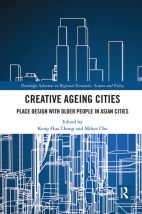Creative Ageing Cities: Place Design with Older People in Asian Cities

Creative Ageing Cities explores ageing-friendly environments in six affluent global cities in East Asia: Singapore, Seoul, Tokyo, Taipei, Hong Kong and Shanghai. The context for this is the demographic “silver tsunami” – the rapidly growing proportion of people aged 70+ – particularly as it affects certain Asian countries. Yet despite their increasing numbers, elderly people are still frequently excluded from discussions and plans for vibrant, resilient cities.
One theme that emerges from the book is that rigidity can be an obstacle to shaping ageing-friendly cities. As the foreword puts it: “One of the lessons learned from the very different Singapore and Seoul cases is that people often desire the right to create their own spaces, making them meaningful in the context of their own lives, and that this desire cannot be satisfied by even the most well meaning provision of standardized services and fixtures.” Avoiding overly prescriptive attitudes towards public space is one way to make cities ageing-friendlier. Another is incorporating the voices of older residents into urban renewal projects.
It can be challenging to nurture elderly placemaking and a sense of local ownership in Tokyo, as illustrated in the chapter on the Akabane-dai Housing Development. Japan has the world’s most aged population, and has seen remarkable increases in life expectancy over the last 100 years. At the same time, its housing stock is frequently redeveloped in order to meet disaster-resilience requirements, which can be destabilizing for elderly residents. Gerontologists, architects, planners and policymakers have rallied around reducing the number of people who die alone in their homes, for instance in age-sensitive temporary housing. Something as simple as placing a bench in a laundromat can encourage conversation among elderly men, who can be hard to reach socially with planned activities.
Ultimately, the most effective jumping-off points appear to be the existing habits and desires of elderly residents, rather than the assumptions of younger officials who neglect to actually listen to varied older people. As Creative Ageing Cities concludes:
While having struggled to overcome colonial legacies, war wounds, and poverty, many cities in Asia have focused on growth, revamp, and conformity. As a result, cities are not friendly to people, especially older people…future policymakers and designers should first learn from how people are ageing creatively, thereby encouraging people to participate in their own place-making and community-making, fostering social creativity and co-producing their life space, encouraging diverse forms of senior communities, and, finally, reimagining new possibilities in urban spaces and architectural design typologies.
Further reading:
Beard, John R and Charles Petitot (2010), “Ageing and urbanization: Can cities be designed to foster active ageing?”, Public Health Reviews Vol 32, pages 427–450, available at https://publichealthreviews.biomedcentral.com/articles/10.1007/BF03391610.
Cho, Mihye and Jiyoun Kim (2016), “Coupling urban regeneration with age-friendliness: neighborhood regeneration in Jangsu Village, Seoul”, Cities Vol 58, pages 107–114, available at https://idc.sutd.edu.sg/wp-content/uploads/sites/10/2016/05/2016-Coupling-urban-regeneration-with-age-friendliness-Neighborhood-Regeneration-in-Jangsu-Village-Seoul.pdf.
Iossifova, Deljana (2015), “Everyday practices of sanitation under uneven urban development in contemporary Shanghai”, Environment and Urbanization Vol 27, No 2, pages 541–554, available at https://journals.sagepub.com/doi/full/10.1177/0956247815581748.
Book note prepared by Christine Ro
Search the Book notes database
Our Book notes database contains details and summaries of all the publications included in Book notes since 1993 - with details on how to obtain/download.
Use the search form above, or visit the Book notes landing page for more options and latest content.
For a searchable database for papers in Environment and Urbanization, go to http://eau.sagepub.com/

